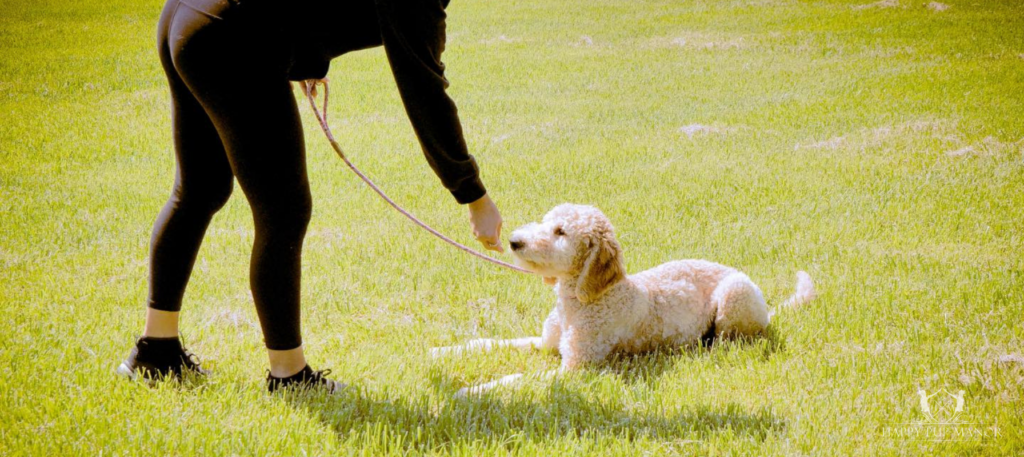Puppy Leash Walking Training: Turning Walks Into a Joyful Adventure

Puppy Leash Walking Training: Turning Walks Into a Joyful Adventure
If you’ve ever said, “My dog pulls when walking,” you’re certainly not alone. But with the right guidance and a little patience, your walks can become calm, connected moments that both you and your pup look forward to.
Puppy leash walking training may seem simple on the surface, but for your puppy, it’s a new and often overwhelming experience. At Happy Pup Manor, leash manners are one of the very first foundations we build. Whether you’re walking through your neighborhood or exploring a new park, teaching your puppy to walk calmly by your side is one of the most rewarding parts of early training—and yes, it can be fun, too.
Why Leash Walking Is Essential for Puppies

Leash training is more than just a skill—it’s a cornerstone of your puppy’s behavioral development. It plays a key role in shaping how your puppy interacts with the world and with you. According to the American Kennel Club, teaching your puppy to walk politely on a leash not only encourages good manners but also nurtures confidence, impulse control, and social awareness.
Leash walking is a daily ritual that sets the tone for your puppy’s emotional and behavioral growth. When done consistently and positively, structured leash walks offer far-reaching benefits:
Keeps You & Your Puppy Safe
Safety is the most immediate reason to begin leash training. A puppy that understands leash cues and responds to your pace is less likely to dart into streets, chase after distractions, or become entangled in unsafe environments. Teaching your pup to stay close, check in with you, and respond to gentle pressure on the leash lays the foundation for safer walks—and quicker response in unpredictable situations.
Engages Their Senses
Walks aren’t just about physical exercise; they’re a form of enrichment. Leash walks allow your puppy to explore the world at a safe pace. New smells, sights, textures, and sounds stimulate their brain, helping to reduce boredom and destructive behaviors at home. These sensory experiences are especially important for breeds with high mental energy or natural curiosity, like retrievers, doodles, and herding dogs.
Develops Their Social Skills
Leash training also plays a key role in early socialization, essential during your puppy’s first few months. Calm exposure to other dogs, people, bikes, strollers, and environmental stimuli helps prevent fear-based behaviors later in life. Structured walks teach your puppy how to behave appropriately around new distractions without becoming overwhelmed, reactive, or overexcited.
Strengthens Bond With You
One of the most beautiful (and often overlooked) benefits of leash training is the bond it builds between you and your pup. When you lead the walk with patience and consistency, your puppy begins to see you as a trusted guide. These moments of shared movement—walking in sync, checking in with one another, pausing together—cultivate trust and reinforce your role as their calm, confident leader. Over time, your puppy will begin to look to you for direction naturally, making all future training easier and more intuitive.
At its best, leash walking isn’t just a means of getting from point A to point B—it’s a daily opportunity for connection, learning, and growth. When approached with intention, these walks can shape your puppy into a polite, well-adjusted companion who feels secure both on and off the leash.
Related Reading: Why Is Puppy Socialization So Important?
When to Start Leash Training

Many new puppy parents ask, “Should I wait until my puppy is fully vaccinated before beginning leash training?” The answer is reassuring: you don’t have to wait. While your puppy should avoid high-traffic public areas until their vaccinations are complete, foundational training can—and should—begin much earlier.
In fact, PetMD recommends introducing basic training as early as 8 weeks of age, when your puppy is still highly impressionable and eager to learn. This early stage, often referred to as the critical socialization window (between 3–14 weeks), is when puppies are most open to new experiences and least likely to form fearful associations.
Starting leash training during this sensitive period doesn’t mean heading straight to the sidewalk or dog park. Instead, we encourage you to begin in a safe, low-distraction environment—like your living room, backyard, or even a quiet hallway. Here, your puppy can get used to the feeling of a collar or harness, learn how to follow your lead, and build confidence without the overwhelm of the outside world.
Remember, the earlier you introduce your puppy to calm, consistent leash guidance, the easier it is to prevent future habits like pulling, lunging, or anxious behavior. Think of early leash work as an investment—not just in manners, but in the lifelong joy of walking together in harmony.
Common Leash Walking Challenges

One of the most common concerns we hear from new puppy parents is, “My dog pulls when walking.” And it’s true—pulling is one of the most frequent issues we address in walking dog training. If your puppy is darting ahead, zigzagging across your path, or straining against the leash, you’re not alone.
So, why do puppies pull?
Simply put: they’re excited, curious, and untrained. The world is a fascinating place, filled with smells, squirrels, people, and movement. Much like a toddler sprinting toward a playground, puppies are driven by instinct and enthusiasm. If they haven’t yet learned how to walk in step with you, they’ll naturally follow their nose—or their impulses—straight to whatever catches their attention.
But here’s the catch: when a puppy pulls and still gets to move forward, they learn that pulling works. Without even realizing it, we may be reinforcing this unwanted behavior by continuing to walk while they’re straining at the end of the leash. Over time, this becomes a habit—one that’s more difficult to break as your puppy grows bigger and stronger.
At Happy Pup Manor, we remind clients that leash training is not about control—it’s about communication. Your leash isn’t just a tool for containment; it’s a line of gentle guidance that helps your puppy understand where to focus and how to move with you, not ahead of you.
Here’s what I always tell our clients:
“Your goal isn’t to restrain your puppy—it’s to teach them that staying close to you is the most rewarding place to be.”
When we approach leash training with a calm, consistent structure and positive reinforcement, we teach puppies that checking in with their handler is more rewarding than chasing the next distraction. Over time, this shift in mindset transforms a chaotic walk into a calm, cooperative experience.
Some of the most common leash walking challenges include:
- Sudden Lunging: Often triggered by another dog, a person, or a moving object. This can be managed with focus exercises and desensitization techniques.
- Excessive Sniffing or Stopping: While some sniffing is natural and enriching, excessive stopping can interrupt the flow of the walk. Teaching a “Let’s go” cue can help your puppy re-engage with you.
- Zigzag Walking: Common in the early stages when puppies don’t yet understand pacing. Teaching a consistent heel position and rewarding proximity to your side helps reduce this.
- Freezing or Refusing to Walk: Especially common in more cautious puppies or in new environments. Building confidence with short, low-pressure sessions often helps ease this behavior.
If any of these challenges sound familiar, know that they’re perfectly normal—and completely solvable with the right approach. Our training team uses gentle redirection, clear communication, and a healthy dose of patience to help even the most enthusiastic pullers become calm, collected walkers.
Related Reading: How Do I Teach My Dog to Focus?
Happy Pup Manor’s Top Tips for Puppy Leash Training Success

Let’s turn that tug-of-war into a relaxed, elegant walk. Here are our tried-and-true methods for effective puppy training walking on a leash:
1. Choose the Right Equipment
Not all collars and harnesses are created equal. At Happy Pup Manor, we recommend gear based on your puppy’s size, breed, and temperament. You can learn more in our guide to choosing the right collar. For beginners, a front-clip harness is often best, as it gently discourages pulling without putting pressure on your puppy’s neck.
2. Start Indoors First
Practice walking on leash in your living room or yard where there are minimal distractions. This helps your puppy focus on you and learn the basics in a calm setting.
3. Use Positive Reinforcement
Mark and reward calm walking with treats, praise, or a clicker. The American Kennel Club emphasizes that puppies learn best through consistency and rewards, not punishment.
4. Keep Sessions Short
Young puppies have short attention spans. Start with 5-10 minute sessions and gradually increase as your pup builds focus and stamina.
5. “Be a Tree” When They Pull
If your puppy pulls, stop walking immediately. Wait for the leash to slacken, or lure your puppy back to your side before continuing. This teaches them that pulling doesn’t get them where they want to go—walking nicely does.
6. Practice Makes Polite
Leash training isn’t a one-time lesson—it’s a habit that develops through repetition. Be patient, and celebrate even small progress.
Keep Reading: The Importance of Positive Reinforcement in Dog Training
When to Call in the Pros
If leash training becomes a struggle, don’t worry—you’re not alone, and you’re not failing. Some puppies simply need more structure, time, or support. Our puppy leash walking training programs provide expert-level instruction with daily leash work, socialization, and confidence-building in a calm, controlled setting. Your pup will return home with not just manners but the ability to walk gracefully by your side.
Leash walking is more than just a way to burn off energy—it’s a beautiful opportunity to bond, explore, and build trust with your puppy. With the right approach, puppy training walking on a leash becomes something both of you enjoy.
If you’re looking for guidance, structure, or a trusted training retreat while you travel, reach out to us at Happy Pup Manor. We’d be honored to help your puppy master the art of the elegant walk!











